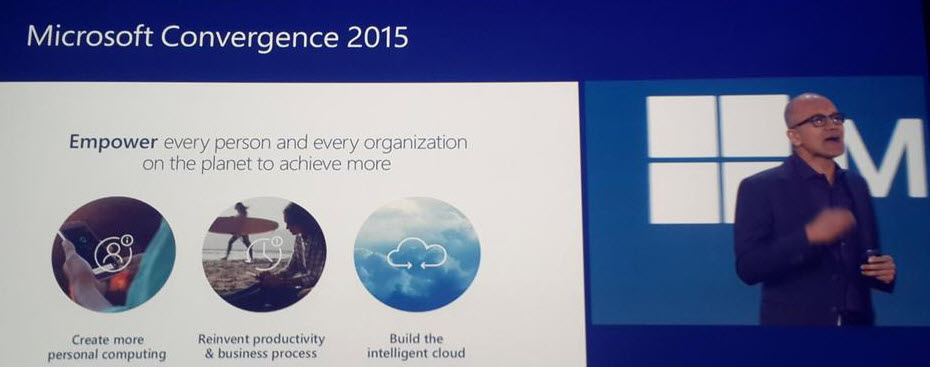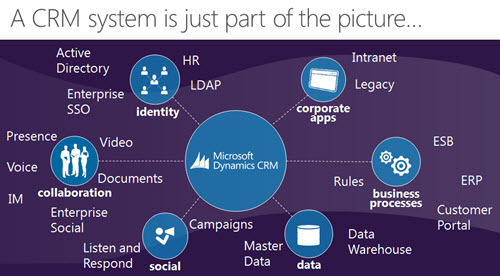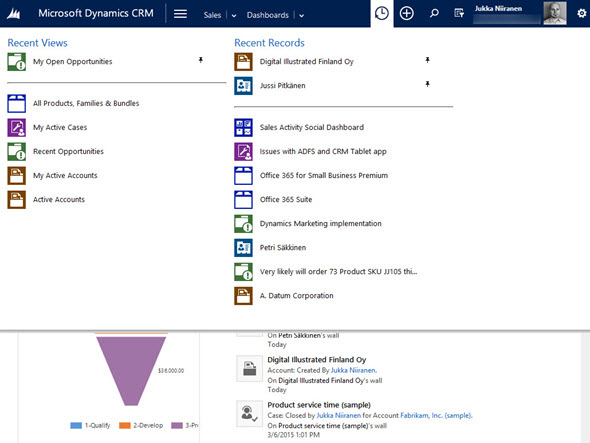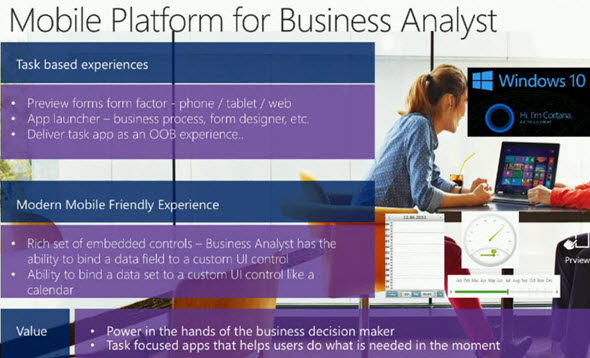Related sites:
Newsletter: Perspectives on Power Platform
Company: Niiranen Advisory Oy

Hey, did you notice what happened in Atlanta last week? Yup, it was again that time of the year when the Dynamics CRM & ERP crowd gathers together at Microsoft Convergence. Instead of packing my bags and hopping on a plane, I once again opted to staying at the comfort of my own home and instead opened up Tweetdeck to keep an eye on all the great content being shared by Dynamics community members on the social networks.
With Satya Nadella himself opening up the event, it was clear that this year Convergence was going to be about a much broader spectrum of Microsoft solutions than just the Dynamics products. Although Satya is a former CRM blogger, he wasn’t there just to prove he still can build cool mashups with the XRM toolkit but rather to tell the higher level story of what business benefits companies can expect to gain from using the latest and greatest cloud technologies that Microsoft today offers. This is of course the fundamental reason behind why applications like Dynamics CRM are being deployed, and with the ever growing complexity of technologies intertwined together to support digital business, it’s important to increase the customers’ awareness of the types of end results they could be pursuing with the use of this technology.

So, while technology is just the means to an end and CRM is just one (central) part of a modern business technology stack, it’s still the area in which I personally strive to deliver the biggest positive impact to our customers. That is why I’ve decided to write down a few notes about what Convergence 2015 announcements you should pay attention to if you also happen to work with Dynamics CRM.
Known by the codename “Carina”, the next CRM release scheduled for this spring was officially revealed at Convergence 2015. The “What’s New” page for the upcoming version is already live and so is the admin content on TechNet, as well as the developer content on MSDN. The official name for Spring ’15 appears to be “CRM Online 2015 Update 1“, which is a bit of an awkward choice since based on the aforementioned documentation Vega a.k.a. CRM 2015 was called “CRM Online 2015 Update” (without a number, so presumably “Update 0”). Oh well, we all know product marketing names at Microsoft are an eternal mystery, so it’s easier if we stick to the recently simplified version numbers instead. Vega was CRM 7.0 and this next update is CRM 7.1 (but before that we’ll still get UR1 which is 7.0.1…).
Okay, enough with the numbers. Considering that 7.1 isn’t a new Dynamics CRM major version release but merely a minor version, there sure are plenty of new features and enhancements packed into this next release. I won’t try to list them here as you’re better of reviewing the above links, but the one feature that you simply can’t miss is the new Navigation Bar. You can see it live in action in this video and let me tell you from my experience with using a Carina preview org, it’s love at first click!
Arguably the single biggest gripe people had with the refreshed UI introduced in CRM 2013 was the Nav Bar with its ability to only show ~7 menu items on a single screen, then requiring you to scroll right and play really close attention to not moving your mouse cursor too far or the whole menu would collapse. Microsoft has now taken the menu structure introduced in Dynamics Marketing (which has a lot of menu items in its navigation) and brought it over to the world of Dynamics CRM. We now get a “hamburger” menu button that opens the first level (Sales, Service, Marketing, etc.) and clicking on one of them shows us all the included menus aligned vertically, broken down into subgroups. While this does show many more items to the user at once, it’s still a considerably smaller cognitive burden than trying to remember where you need to click to reveal a menu item that’s not on the screen, which happens all the time with the current version.
The initial reaction to the new Nav Bar from the CRM folks over on Twitter was extremely positive. This feature in combination with the revised MRU menu (most recently used items) that supports pinning records and views into the Nav Bar is certainly going to improve the user experience of Dynamics CRM considerably. Although it’s still advisable to optimize the structure and contents of the Sitemap to remove unnecessary items and promote the most important menus, the larger menu canvas is very much needed in more complex environments with a high number of custom entities that simply need to be shown to the users somewhere.

The one thing that’s somewhat inconvenient about this updated navigation is that it will be initially made available only to CRM Online users. Yes, in case you have missed it, Carina / v7.1 is an Online-only release that will not be made available to on-premises customers. This was the initial plan already one year ago with the Leo release, but that then eventually turned into an Online+onprem release as Microsoft Dynamics CRM 2013 Service Pack 1 was made available for download to all CRM 2013 customers. Don’t expect to see such a change of heart this time around. The new features announced are expected to become available to on-premises customers in the next major release “Ara” (8.0) later this year.
Considering how challenging it can be for customers to keep their own CRM servers up-to-date with this rapid release cadence from the Dynamics team, it’s perhaps not such a big loss to have a new set of bits to install only once per year. Except for Update Rollups, of course, like the latest CRM 2015 UR1 that is actually going to bring one whole new feature for on-prem with full-text Quick Find.
We have seen Online-only releases already with Polaris, so it’s not a completely new situation. It does however mean that if you want to develop Dynamics CRM solutions that leverage the new capabilities of Carina / 7.1 then your dev org needs to be in the cloud, too. All the platform related enhancements like upsert, alternate keys, change tracking, Web API Preview (seriously, go and read the updated SDK documentation already!) can only be used in CRM Online for now, so you’d probably want to consider having additional non-production orgs in the cloud rather than local VM’s if you want to be at the very forefront of Dynamics CRM development.
Although it was mentioned in the blog post from Bob Stutz during the opening day of Convergence 2015, this piece of news didn’t seem to get very much attention in the media or Microsoft’s presentations yet. MS announced they have acquired IP (intellectual property) from Fusion Software on a software product that adds “voice of the customer” capabilities to their CRM offerings. In layman’s terms, Microsoft bought the Mojo Surveys product that allows users to build questionnaire forms inside Dynamics CRM and automate the process around data collection. The press release from Fusion Software gives a bit more insight into this deal.
3rd party marketing automation products like ClickDimensions have offered the tools for building simple survey forms into CRM for a while now, but these are more like extensions to basic web forms rather than solutions for complex questionnaire design and data collection. Microsoft’s own Dynamics Marketing product has so far lacked a similar survey form feature, which makes it easy to understand why MS was in the market for acquiring the required technology to fill this gap.
There weren’t much details shared yet about what the commercial product offering around the survey features would be like once this becomes an official Microsoft application. Thinking about the current push MS has towards its Dynamics Marketing and Parature (service) products, customer feedback management could be seen as a welcome capability in each of these. What’s interesting about the Mojo Surveys deal is that unlike the previous CRM related acquisitions (Yammer, Marketing Pilot, NetBreeze, Parature) this isn’t a separate application living outside of CRM. It’s a proper XRM solution developed by Fusion Software on top of the CRM platform, so we don’t need to wait for the development of connector software (like with Dynamics Marketing) or UI extensions (á la Yammer feed, Social Listening widgets, Parature KB articles) to start leveraging the new functionality alongside the core customer data stored in Dynamics CRM.
It wasn’t only the Mojo Surveys deal that brought the concept of eXtended Relationship Management back onto the stage at Convergence 2015. For the past few years Microsoft has been clearly putting more emphasis on developing the application side of Dynamics CRM, trying to make it a product that can better serve the common needs of sales, service and marketing users with out-of-the-box features and configuration, rather than an application platform that always requires customization efforts before it can be presented to end users. This has left some of the XRM developers wondering whether the platform story will have a happy ending or is Dynamics CRM destined to turn into a less extensible application with the main focus on out-of-the-box features.
Convergence 2015 had a session dedicated to the XRM development capabilities, but the most interesting piece of information around this topic was shared in the Mobility strategy and roadmap session. Not only did MS promise us that the long awaited offline support would finally arrive for mobile clients, but they presented a 6-12 month roadmap with the target of evolving their mobile offering into an actual platform and not just a packaged app for tablets and smartphones.

The new CRM Phone client demonstrated at Convergence 2015 certainly looks a lot better than the earlier CRM 2013 version that was pretty much just the Mobile Express client put inside a native app shim. Still, it’s designed to be a fairly generic CRM client that follows the “configure once, use anywhere” approach that Microsoft is applying on their client application development. This doesn’t necessarily deliver an experience that would be optimized to the context in which the users are accessing CRM while out there on the road. Sure, it’s easy for the admins that they don’t have to configure specific navigation, forms and UI logic for each three client category (web/Outlook, tablet, phone), but in my humble opinion these new usage scenarios for mobile CRM would definitely require a tailored user experience to truly tie them into the business processes that companies are managing via Dynamics CRM.
The promise of “task apps” sounds like it could really enable us to extend the use cases of CRM into areas where no laptop has gone before. Rather than shrinking CRM to a pocket sized app we should be investigating ways in which the ubiquitous presence of CRM data could help companies deliver more coherent customer experiences and how cutting down the barriers for real-time data collection could make everyone smarter about what’s really happening at the customer interaction points. Few companies can afford to develop tailored mobile apps for their personnel, but if the platform offering from Microsoft will extend to cover the basic components of modern mobile apps via custom UI controls and persistent offline data on the device, all the while hooking it up to the power of Dynamics CRM processes, this can have a much more far reaching impact than custom apps and CRM API’s. It’s hard to say yet whether this is where Microsoft will really be heading and how long will it take for them to get there, but it’s definitely something to keep an eye on.
(By the way, please do note that only CRM Online orgs can be accessed with the new Phone app until Ara / v8.0 arrives.)
There were far, far too many new feature announcements in the Dynamics CRM space from Convergence 2015 that could be sensibly covered in a single blog post. That’s always been the case, but especially this year it felt like there was a nonstop flood of big news from the CRM camp: OneNote integration, Excel Online support, using CRM with Office Groups, new Power BI dashboards, CRM content discovered via Delve, recommendations via Azure ML… That’s before even mentioning what’s going on in the other three tracks (Dynamics Marketing, Social Listening Engagement, Parature).
What’s awesome about Convergence is that pretty much all the sessions can be viewed in the Convergence Video Library site that you can access simply by filling in your email address, no paid conference attendance required. While that’s a great resource to have, saying “go and watch tens of hours worth of videos” isn’t perhaps so encouraging for people who’d just want to keep up with the highlights of what’s happening with Dynamics CRM. In an attempt to capture a snapshot of all the buzz at Convergence 2015, I’ve once again curated “stories” of the #CONV15 content shared over on Twitter and published them on Storify.
Enjoy!
Thank you Jukka for summarising the event for those of us who could not be there. Appreciate you effort!
[…] CRM. In addition to explaining what business scenarios CRM is typically used for and how the latest announcements from Convergence 2015 are shaping up the platform’s future in Microsoft’s product portfolio, we also had an […]
Jukka you are the finest virtual tour guide. Feels like I was there now!
Hi Jukka,
Export to excel new limit is said to be 100.000 instead of default 10.000. But from what I read, they only mention it regarding Online-version. Is that new feature also applicable to the On Premise version?
Peter, there is no new version of Dynamics CRM for on-premises released in Spring 2015, hence none of the new features are yet available for it. I think it’s safe to assume that the improved Excel integration features in CRM Online 2015 Update 1 will be included in the next major release (CRM 2016 or something like that) later this year, although setting up the Excel web app integration will surely be a bit more complex in on-prem surroundings.
[…] Back in the early days of XRM a.k.a. “Any Relationship Management” the concept of having Dynamics CRM serve as the foundation on top of which organizations could build their own relational business applications and potentially replace legacy LoB systems sounded perfectly valid. The XRM idea was conceived in the on-premises days, though, where the business owners couldn’t just go and subscribe to a cloud app of their choice to solve their problem with a bit of shadow IT. Sure, they could have also requested an XRM org to be customized for this purpose, but 99% of them probably weren’t familiar with the concept. Oh well. The capability is nevertheless there in the platform that all Dynamics CRM applications run on today, and MS even hinted at more emphasis being put onto the XRM toolkit during Convergence 2015 presentations. […]
Hi Jukka! Do you have any more information regarding the purchase of Mojo survey, and when to expect this module to be available for CRM 2015 on-prem?
Jo, Microsoft hasn’t disclosed publicly any plans yet on how & when the Mojo Surveys functionality will be offered to Dynamics CRM customers. I’d suggest you keep an eye on the Fall 2015 release preview materials that will probably become available in the near future via the official Dynamics CRM blogs. Also, if you’d want to join the Fall 2015 Preview Program to learn more about the upcoming releases before the public announcement, then here are instructions on how to sign up for the program.